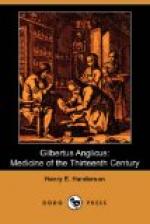[Footnote 3: Janus, 1903, p. 20.]
The “Liber de speculis” mentioned by Gilbert (f. 126 c), and since the time of Freind generally accepted as the work of Bacon, is almost certainly not from the pen of that eminent philosopher. In addition to the fact that Bacon himself says he had (for obvious reasons) written nothing except a few tracts (capitula quaedam) prior to the composition of his Opus Magnum in 1267, the real author of the Liber de speculis is probably mentioned by Bacon in the following passage from the Opus Tertium:
“Nam in hoc ostenditur specialiter bonitas naturae, ut dicit auctor libri de speculis comburentibus."[4]
[Footnote 4: Cap. XXXVI, p. 116, edition of Brewer.]
We must therefore agree with Dr. Payne that the Liber
de speculis of
Gilbert was at least not the work of Roger Bacon.
Dr. Freind regards the chapters of Gilbert on the subject of leprosy as borrowed substantially from the “Chirurgia” of Theodorius of Cervia, who wrote about the year 1266. This view has also been generally accepted by later writers. But Dr. Payne boldly challenges the view of Freind, declares that Theodorius copied his chapters from Gilbert, and asserts that Theodorius was a notorious plagiarist. Now, while the bold assertion of Dr. Payne cannot, of course, be accepted as proof of Gilbert’s precedence in chronological order, if that precedence is otherwise established, it will explain the similarity of the chapters of the two writers very satisfactorily. For the present, however, this similarity can be adduced as evidence on neither side.
Again, Gilbert, with the enthusiasm of a loyal pupil, speaks (f. 47 b) of a certain Magister Ricardus, “omnium doctorum doctissimus,” whose views on uroscopy certainly indicate a mind superior to his age. Now there were about this period at least two eminent physicians who bore the name of Ricardus. Of these the senior, a Frenchman, known also as Ricardus Salednitanus, is highly praised by Aegidius of Corbeil (Gilles de Corbeil, Aegidius Corboliensis), physician to King Philip Augustus of France (1180-1223). This Ricardus was a famous teacher at Salernum when Aegidius was in attendance at that famous university, therefore probably about the close of the 12th century. The second Ricardus, called Parisiensis, has been recently identified by Toply with Richard of Wendover, an English canon of St. Paul’s, and at one time physician to Pope Gregory IX, who died in 1241. Toply believes him to have been also the author of the “Anatomia Ricardi,” recently published. This Ricardus died in 1252.




